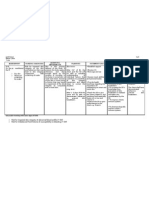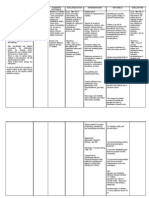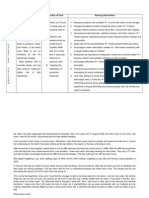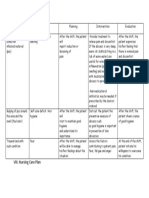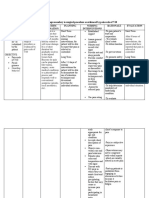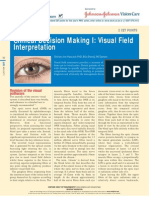NCP
NCP
Uploaded by
fairwoodsCopyright:
Available Formats
NCP
NCP
Uploaded by
fairwoodsCopyright
Available Formats
Share this document
Did you find this document useful?
Is this content inappropriate?
Copyright:
Available Formats
NCP
NCP
Uploaded by
fairwoodsCopyright:
Available Formats
LIST OF PRIORITY PROBLEMS:
1. Acute pain related to multiple injury and abrasions
2. Decreased intracranial adaptive capacity related to injury with cerebral edema
NURSING CARE PLAN
Cues/Needs Nursing Rationale Goals and Interventions Rationale Evaluation
Diagnosis Objectives
Subjective: Acute pain Multiple abrasion on After 2 hours of Independent After 2 hours of
“Medyo related to face and legs continuous continuous
masakit pa multiple stimulates the nursing care nursing care
din yung mga injury and nociceprors, free interventions, Accept client’s description • Pain is subjective interventions,
mga sugat abrasions nerve endings in the the patient will of pain. Acknowledge the experience and cannot the client was
ko” as skin that respond be able to pain experience and convey be felt by others. able to verbalize
verbalized by only to intense, verbalize relief of acceptance of client’s relief of pain. As
the patient. potentially pain. As response to pain. manifested by:
damaging stimuli. manifested by: Encourage the client to • This helps alleviate Pain scale
Pain scale of Once the With 1 discuss problems related to anxiety. Client may feel of 3/10
5/10 nociception is being no current condition need to relieve the (With 1
initiated, the pain and traumatic experience being no
Objective: nociceptive action 10 being Move patient slowly and pain and
Guarding potentials are severe deliberately • This reduces muscle 10 being
behavior transmitted by the pain, the tension or guarding, severe
towards his peripheral nervous patient’s which may help pain)
hands and system. The first- pain would minimize pain of Less facial
legs order neurons travel be <5 Encourage use of these movement mask of
Facial Mask from the periphery Less facial techniques: pain
of pain (skin) to the spinal mask of Distraction techniques
cord via the dorsal pain GOAL IS FULLY
horn. This results to MET
activation of the • These heighten one’s
ascending system. concentration upon non-
Once activated, the painful stimuli to
inhibitory decrease one’s
interneural fibers in awareness and
the dorsal horn Relaxation exercises, experience of pain.
inhibit or turn off breathing exercises, Some methods are
the transmission of and music therapy breathing modification
noxious stimulating and nerve stimulation.
information in the • Techniques are used to
ascending pathway. bring about a state of
Thus, pain is felt. physical and mental
Encourage client to awareness and
Sources: eliminate additional tranquility. The goal of
stressors or sources of these techniques is to
• Brunner and discomfort whenever reduce tension,
Suddharth’s possible. subsequently reducing
Textbook of pain.
Medical Nursing • Client may experience
11th edition, an exaggeration in pain
volume 1;p264, or a decreased ability to
265 tolerate painful stimuli if
Instruct client to have rest environmental and
periods to facilitate comfort, intrapersonal, or
sleep and relaxation intrapsychic factors are
further stressing them.
• The client’s experience
of pain may become
exaggerated as the
result of fatigue in a
cyclic fashion; pain may
result in fatigue which
may result in
Instruct patient to refrain exaggerated pain and
from excessive exertion, exhaustion. A quiet
such as: environment, a
Crying darkened room, and the
Coughing disconnected phone are
Straining all measures geared
toward facilitating rest.
Blowing the nose • This prevents undue
and strain on injured site
Sleeping on the
injured side
DEPENDENT
Administer mefenamic acid
500 mg 1 capsule every 6
hours
• This is an aspirin-like
drug that has analgesic,
antipyretic and anti-
inflammatory activities.
These activities appear
to be due to its ability to
inhibit cyclooxygenase
and also antagonize
certain effects of
prostaglandins.
Mefenamic acid displays
central and peripheral
activities.
Cues/Needs Nursing Rationale Goals and Interventions Rationale Evaluation
Diagnosis Objectives
Subjective: Decreased After 8 hours of Independent
“Nahihilo ako intracranial Hematoma which nursing Goal was fully
pag umuupo adaptive resulted from the interventions, met
ako” as capacity accident , increases the patient will Assess neurological status • Deteriorating
verbalized by related to the pressure within maintain an according to GCS- pupil neurological signs After 8 hours of
the patient. injury with the cranial vault. optimal cerebral size, reaction and symmetry indicates increased nursing
cerebral During trauma, tissue perfusion to light; speech and thought cerebral ischemia. A interventions,
Pain scale of edema there is a as evidenced by processes; motor sensory decreased level of the patient
disturbance in ICP less than 10 maintained an
5/10 auutoregulation and mmhg; GCS signs and reflexes consciousness is the first optimal cerebral
intracranial pressure within normal. sign of increased ICP. tissue perfusion
Objective: is increased. Evaluate presence or • Loss of protective as evidenced by
vomiting absence of protective reflexes increases risk ICP less than 10
decreased reflexes (swallowing, for injuries such as mmHg; GCS
pupil gagging, blinking and aspiration. within normal; no
activity coughing) vomiting noted
• Elevation promotes and improved
Elevate head of the bed 30 venous outflow. A pupil reactivity.
degrees and keep head in neutral head position
neutral alignment. prevents venous
obstruction
• Valsalva increases
Avoid valsalva maneuver intracranial pressure
DEPENDENT:
• Mannitol reduces
Administer Mannitol 100 ml cerebrospinal pressure
every 6 hours by increasing plasma
osmolality.
You might also like
- NCP For Urinary RetentionDocument5 pagesNCP For Urinary RetentionColeen Comelle Huerto60% (5)
- NCP Acl TearDocument2 pagesNCP Acl TearEd Pascasio100% (3)
- Science 3 DLP 1 - Sense Organs and Their FunctionsDocument16 pagesScience 3 DLP 1 - Sense Organs and Their FunctionsRussel Jane Sumonod - Maraguinot100% (5)
- NCP Acute PainDocument1 pageNCP Acute PainBianca Freya Porral100% (2)
- Nursing Care PlansDocument10 pagesNursing Care PlansGracie S. Vergara100% (3)
- Activity IntoleranceDocument2 pagesActivity IntoleranceMaze Reyes40% (5)
- NCP - Risk For Impaired Skin Integrity R/T Dry Skin and Behaviors That May Lead To Skin Integrity Impairment AEB Scratching of ScabsDocument1 pageNCP - Risk For Impaired Skin Integrity R/T Dry Skin and Behaviors That May Lead To Skin Integrity Impairment AEB Scratching of ScabsCarl Elexer Cuyugan Ano100% (4)
- NCP BkaDocument4 pagesNCP BkaKeeshia CesnerosNo ratings yet
- NCP OrthoDocument5 pagesNCP OrthoMyluck Elaine Wailan100% (4)
- NCP-Esophageal Varices Pleural EffusionDocument6 pagesNCP-Esophageal Varices Pleural Effusiontinatin98933% (3)
- NCP PainDocument4 pagesNCP PainFlauros Ryu Jabien100% (1)
- Impaired Physical Mobility. NCPDocument1 pageImpaired Physical Mobility. NCPwguino100% (3)
- NCP Risk For Infection Secondary To Vehicular AccidentDocument2 pagesNCP Risk For Infection Secondary To Vehicular AccidentXerxes DejitoNo ratings yet
- NCP Impaired Physical MobilityDocument2 pagesNCP Impaired Physical MobilityJohn Michael FernandezNo ratings yet
- NCP FractureDocument2 pagesNCP Fracturemawel50% (2)
- NCP FractureDocument3 pagesNCP Fracturesarzlasco09No ratings yet
- NCP - Acute PainDocument3 pagesNCP - Acute PainRene John Francisco0% (1)
- NCP of Impaired MobilityDocument3 pagesNCP of Impaired MobilityHazel Cabrera0% (1)
- NCP Acute Pain R/T Injuring AgentsDocument4 pagesNCP Acute Pain R/T Injuring AgentsKevin Sam AguirreNo ratings yet
- (NCPS) Impaired Physical Mobility 2Document2 pages(NCPS) Impaired Physical Mobility 2roren100% (1)
- XIII. NCP Risk For FallsDocument1 pageXIII. NCP Risk For FallsMartin T Manuel100% (2)
- Acute Pain Related To InjuryDocument2 pagesAcute Pain Related To InjuryErickson Caisido GarciaNo ratings yet
- Nursing Care Plan For Risk For Aspiration NCPDocument4 pagesNursing Care Plan For Risk For Aspiration NCPaudreyNo ratings yet
- NCP Knowledge DeficitDocument1 pageNCP Knowledge Deficittspears82100% (2)
- NCP For FractureDocument2 pagesNCP For FractureArnie Jude Carido100% (1)
- Concept MapDocument2 pagesConcept Mapjunifer laynoNo ratings yet
- NCP - Risk For FallsDocument5 pagesNCP - Risk For FallsMae CeaesarNo ratings yet
- Acute Pain Related To Tissue Trauma 2° To MVADocument1 pageAcute Pain Related To Tissue Trauma 2° To MVARachel Saavedra100% (3)
- Acute Pain NCPDocument3 pagesAcute Pain NCPMjhay Montemayor100% (1)
- NCP Impaired Physical MobilityDocument2 pagesNCP Impaired Physical MobilityKristine Young50% (2)
- NCPDocument2 pagesNCPTrishaYsobelleMedianteMorales100% (1)
- NCP Impaired MobilityDocument4 pagesNCP Impaired MobilityLouis LazaroNo ratings yet
- NCP FractureDocument3 pagesNCP FractureDino V EscalonaNo ratings yet
- NCP For Impaired Physical MobilityDocument1 pageNCP For Impaired Physical Mobilityitzme_andreaNo ratings yet
- NCP (Risk For Fall)Document1 pageNCP (Risk For Fall)Erika GardeNo ratings yet
- BPPV NCPDocument2 pagesBPPV NCPNiña Mae Marasigan67% (3)
- Nursing Diagnosis Risk For Impaired Skin IntegrityDocument2 pagesNursing Diagnosis Risk For Impaired Skin IntegrityRazz Domenique Reyes Escaros100% (5)
- Nursing Care Plan Risk For Skin BreakdownDocument3 pagesNursing Care Plan Risk For Skin BreakdownShelli Miller Pryor82% (11)
- NCP Impaired Physical Mobility Acute PainDocument8 pagesNCP Impaired Physical Mobility Acute PainAi RouNo ratings yet
- Post Open Reduction Internal Fixation PathophysiologyDocument3 pagesPost Open Reduction Internal Fixation PathophysiologyRizalyn QuindipanNo ratings yet
- Assessment Diagnosis Planning Intervention Evaluation: VIII. Nursing Care PlanDocument1 pageAssessment Diagnosis Planning Intervention Evaluation: VIII. Nursing Care PlanKriz_sakuradreamNo ratings yet
- NCP: Impaired Physical Immobility Related To Loss of A Limb (Amputation)Document5 pagesNCP: Impaired Physical Immobility Related To Loss of A Limb (Amputation)RazelAnneValinoNo ratings yet
- NCP 2Document3 pagesNCP 2romelyn100% (1)
- NCP For Ineffective Breathing Pattern - RMC CasepressDocument2 pagesNCP For Ineffective Breathing Pattern - RMC Casepressmissyuri08No ratings yet
- Body Weakness NCPDocument1 pageBody Weakness NCPArnold Christian QuilonNo ratings yet
- NCP Acute PainDocument3 pagesNCP Acute PainSheene Lysethea Sioteco AguilosNo ratings yet
- Acute Pain NCPDocument1 pageAcute Pain NCPJed AvesNo ratings yet
- Cues Nursing Diagnosis Scientific Reason Objective Nursing Intervention Rationale EvaluationDocument4 pagesCues Nursing Diagnosis Scientific Reason Objective Nursing Intervention Rationale Evaluationjomsportg0% (1)
- NCPDocument2 pagesNCPHippocrates Impressionist CostalesNo ratings yet
- NCPDocument2 pagesNCPsphinx809100% (2)
- Self Care DeficitDocument3 pagesSelf Care DeficitAddie Labitad100% (2)
- NCP FractureDocument7 pagesNCP FractureMacris BondocNo ratings yet
- Impaired Physical MobilityDocument2 pagesImpaired Physical MobilityJane Loriezel Medina Fajardo0% (1)
- NCP DMDocument4 pagesNCP DMAarav (мя Ρєяfєт)No ratings yet
- NCP TahbsoDocument18 pagesNCP TahbsoKe EjieNo ratings yet
- NCP Close Complete FractureDocument3 pagesNCP Close Complete FractureArt Christian RamosNo ratings yet
- Nursing Care Plan: Patient Name: James Japitana AGE:28 Sex:Male DiagnosisDocument4 pagesNursing Care Plan: Patient Name: James Japitana AGE:28 Sex:Male DiagnosisGaming BoyNo ratings yet
- Appendicitis NCPDocument5 pagesAppendicitis NCPEarl Joseph DezaNo ratings yet
- Appendicitis - NCPDocument5 pagesAppendicitis - NCPEarl Joseph Deza100% (1)
- Assessment Nursing Diagnosis Scientific Explanation Planning Intervention Rationale Evaluation IndeoendentDocument3 pagesAssessment Nursing Diagnosis Scientific Explanation Planning Intervention Rationale Evaluation IndeoendentDiane Sarino CabonceNo ratings yet
- Nursing Care Plan: Subjective Cues: Sakit IndependentDocument4 pagesNursing Care Plan: Subjective Cues: Sakit IndependentalambatinjrrNo ratings yet
- NCPDocument5 pagesNCPAthea Melosantos100% (1)
- Team Charter FormDocument1 pageTeam Charter FormfairwoodsNo ratings yet
- Strategic Plan 2011 AbstractDocument19 pagesStrategic Plan 2011 AbstractfairwoodsNo ratings yet
- History Essay Outline: Impact of 9/11 On Canada-United States RelationDocument1 pageHistory Essay Outline: Impact of 9/11 On Canada-United States RelationfairwoodsNo ratings yet
- Ten Principles of Good Interdisciplinary Team Work: Research Open AccessDocument11 pagesTen Principles of Good Interdisciplinary Team Work: Research Open AccessfairwoodsNo ratings yet
- Bender Clincal Nurse ManagerDocument10 pagesBender Clincal Nurse ManagerfairwoodsNo ratings yet
- Homelessness and Hope 8Document4 pagesHomelessness and Hope 8fairwoodsNo ratings yet
- Overcoming Homelessness: Abstract (Summary)Document4 pagesOvercoming Homelessness: Abstract (Summary)fairwoodsNo ratings yet
- Not Competing Was Strategy of Choice Used by NurseDocument3 pagesNot Competing Was Strategy of Choice Used by NursefairwoodsNo ratings yet
- Homelessness and Hope 3Document4 pagesHomelessness and Hope 3fairwoodsNo ratings yet
- Mishkin 1983 PDFDocument4 pagesMishkin 1983 PDFamandaNo ratings yet
- Vision Research: Oliver Braddick, Janette AtkinsonDocument22 pagesVision Research: Oliver Braddick, Janette AtkinsonROHITNo ratings yet
- Classical and Operant Conditioning: Lorna A. Onda BSA-221Document42 pagesClassical and Operant Conditioning: Lorna A. Onda BSA-221Kj Banal100% (1)
- Ear Assessment Checklist ChinnyDocument4 pagesEar Assessment Checklist ChinnyXing-Jin RomeroNo ratings yet
- EXam Practice For ESODocument1 pageEXam Practice For ESOolgaNo ratings yet
- WiFi Radiation Health AssessmentDocument3 pagesWiFi Radiation Health AssessmentKerolus Joseph AminNo ratings yet
- Gaucci - Radiofrequência-1-30Document30 pagesGaucci - Radiofrequência-1-30Fer JorgeNo ratings yet
- Botulinum Toxin Adverse EventsDocument19 pagesBotulinum Toxin Adverse EventsKriti ShuklaNo ratings yet
- CH 7 MseDocument20 pagesCH 7 MseIyanna BaylonNo ratings yet
- Cognitive PsychologyDocument113 pagesCognitive PsychologySTANLEY MAPANDA100% (9)
- Reporting Lesson 1 5Document29 pagesReporting Lesson 1 5Karen Angel AbaoNo ratings yet
- Chapter 14 15 16 PDFDocument158 pagesChapter 14 15 16 PDFTommie100% (2)
- Lumbar Disc HerniationDocument8 pagesLumbar Disc Herniationandra_scooterNo ratings yet
- Psychology Assignment 1Document7 pagesPsychology Assignment 1Abuzar AliNo ratings yet
- Cognitive Rehabilitation For Older AdultsDocument4 pagesCognitive Rehabilitation For Older AdultsJosé Carlos Sánchez-RamirezNo ratings yet
- Short Term and Long Term Memory: Federal Urdu University of Science, Arts and TechnologyDocument5 pagesShort Term and Long Term Memory: Federal Urdu University of Science, Arts and TechnologyxonuNo ratings yet
- 1 s2.0 S1347861316300251 MainDocument107 pages1 s2.0 S1347861316300251 MainNurul HafizaNo ratings yet
- 2nd Quarter Exam k2Document14 pages2nd Quarter Exam k2Melanie Ordanel100% (4)
- MPS Therapy Flyer April 10 2018Document8 pagesMPS Therapy Flyer April 10 2018Neptune ShellNo ratings yet
- Paper TEST - 01.STR.20.7.864Document7 pagesPaper TEST - 01.STR.20.7.864Pranav AgrawalNo ratings yet
- Mov22. Hyperkinetic Disorders 3 (Tics, Myoclonus, Other)Document6 pagesMov22. Hyperkinetic Disorders 3 (Tics, Myoclonus, Other)Monica J Ortiz PereiraNo ratings yet
- Antiepileptic DrugsDocument63 pagesAntiepileptic Drugsvpd100% (1)
- 10 1097@JNN 0000000000000386Document5 pages10 1097@JNN 0000000000000386NYONGKERNo ratings yet
- Dopamine - CNS Pathways and Neurophysiology 549Document7 pagesDopamine - CNS Pathways and Neurophysiology 549Borzoo TajdinNo ratings yet
- Emg Conceptos - Nerve Conduction StudiesDocument23 pagesEmg Conceptos - Nerve Conduction StudiesDeborah SalinasNo ratings yet
- Auditory PerceptionDocument9 pagesAuditory PerceptionFrancis Raymundo TabernillaNo ratings yet
- Clinical NeurocardiologyDocument317 pagesClinical NeurocardiologyadnanNo ratings yet
- Visual Field InterpretationDocument11 pagesVisual Field Interpretationhameed28885No ratings yet






